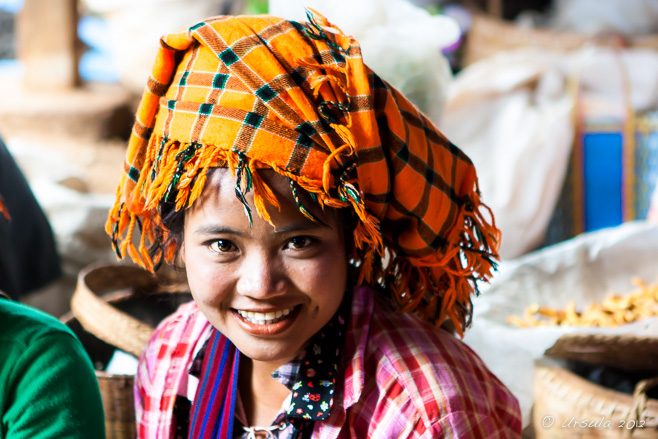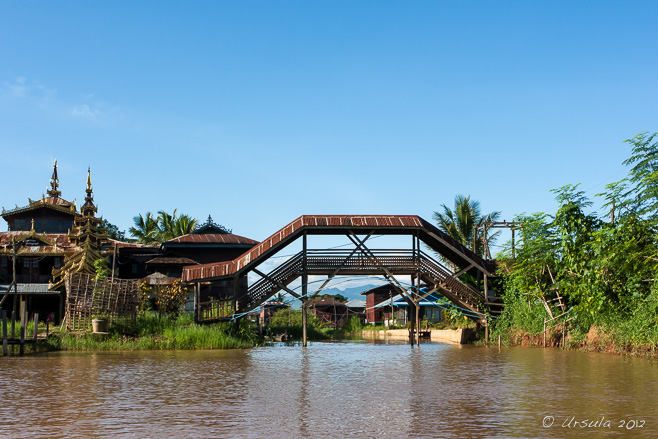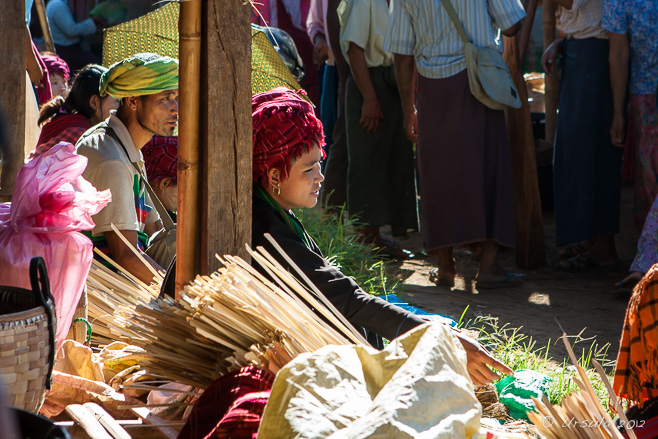
Orange Headdress and Dimples
The Pa’O (Black Karen) people are the second largest ethnic group in the Shan State of Myanmar.
Inle Lake, in the Shan Hills in central Myanmar, is a unique environment.
I’ve written before about it’s floating villages (Life on the Water) and about it’s distinctive leg-rowing fishermen (Iconic Images). Most of the lake’s 70,000 residents live in villages and towns on the shore line, where everyday life includes bustling local markets and quiet Buddhist worship.

Bridge over the Waterways
The villages around the lake are accessible only by boat. Indein (In Dein) Village is a short trip up the Indein River – one of the many rivers in and out of Inle Lake.
My time on Inle Lake included a visit to Indein Village on the western bank, where the local Pa’O (Black Karen) people were conducting their market exchanges in the brilliant, slanting sunlight.

Pa’O Hill People
Called Taungthu, which means ‘hill people’ in Burmese, the Pa’O are the seventh largest ethnic minority in Myanmar.

Pa’O Man
Forced to wear dark indigo-dyed clothing after the defeat of the Mon King Makuta of Thaton by King Anawratha in 1057, today the Pa’O are known for their brightly-coloured turbans.

Pa’O Woman in Red
Considered part of the larger Tibetan-Himalayan ethnic family, the Pa’O have been in Myanmar since around 1000 B.C.

Pa’O Market Woman
Called “Black Karen” by the British colonialists because of the dark blue or black clothing originally enforced on them by King Anawratha, the Pa’O share elements of language and culture with other Karen groups.

A Face in the Crowd
The morning market is a busy place.

Heads Together
Lively exchanges are happening everywhere.

Woman Selling Greens

Young Women

Young Hill Tribe Women
The young women in the markets are happy to engage with us and to be photographed.

Young Women

Cooking Rice Cakes

Monks with Begging Bowls
Wooden carved figurines are among the items for sale.

Buddha-Head and Trinkets
Jewellery made from silver and semi-precious stones is also popular.

Marionettes

Into the Temple
Unlike many Karen groups, the Pa’O have been predominantly Buddhist for centuries.

Old Stones
The area around Indein – sometimes known as Shan Bagan – is dotted with pagodas or stupas, begun in the 12th century and added to by Shan princes up until the 18th century.

Artistic Ability
The corridors leading into the main temple house crafts-people and artisans.

Pa’O Girls
It’s not hard to get the young women to take a break from their gift stalls…

Pa’O Woman
… and pose for us, flashing their dimpled smiles.

Dog at the Chedi Ruins
Many of the stupas or chedi are overgrown and falling into ruins, …

Chedi Ruins
… which is probably not a bad thing, …

Overgrown Stupas
… as there has been criticism of the quality of the restoration work being done.

Fallen Statue

Chedi in the Flowers

Children at the Chedi

Peacock Flowers (Caesalpinia Pulcherrima)

Crumbling Chedi

Boats on the Indein
Too soon, it is time to leave the village – by boat, of course.
Some visitor-reports to TripAdvisor rue the state of the stupas around Indein Village. I think these people may have forgotten that they are not in a theme park: these monuments are built by, and for, the local people as an expression of their faith.
 We are merely visitors.
We are merely visitors.
I am always amazed and pleased by the warmth of the smiling welcome that greets us.
Until next time ~
Pictures: 21September2012



.jpg)



































.png)

